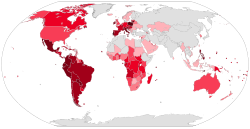History
In 1514, Taiwan was included in the Diocese of Funchal as a missionary jurisdiction; there was some organized Catholic activity on the island. In 1576, the first Chinese diocese, the Diocese of Macau, was established in Macau, a Portuguese colony, and covered most of China as well as Taiwan. The diocese of Macau was sub-divided several times over the next few centuries. In 1626, Northern Taiwan became a Spanish colony. In 1631, Jacinto Esquivel, a Spanish Dominican friar, built a church in Northern Taiwan. In chronological order, Taiwan belonged to the Archdiocese of Manila (1627), the Apostolic Vicariate (now Archdiocese) of Nanking (1660), the Apostolic Vicariate of Fujian (now the Archdiocese of Fuzhou) (1696) and the Apostolic Vicariate (now Diocese) of Amoy (1883).
In 1913, the Apostolic Prefecture of the Island of Taiwan (then called Formosa in foreign languages) was established out of the Diocese of Amoy. It was renamed Apostolic Prefecture of Kaohsiung in 1949, when the Apostolic Prefecture of Taipei (now the Archdiocese of Taipei) was established out of its territory.
Before the end of World War II the Catholic Church had a very minor presence in Taiwan, based mainly in the south of the island and centred on Spanish Dominican priests who went there from the Philippines in the 1860s. In 1948, there were less than 10,000 Catholics on Taiwan and 15 clergy. [8] : 187 The end of World War II and the following years saw a mass migration of religious communities from mainland China as Communist persecution began to take effect following the Chinese Communist Revolution in 1949. As a result, the Catholic Church has many Mandarin-speaking emigrants from the mainland.
In September 1951 the Papal Internuncio to China was expelled to Hong Kong. Since 1952, the Papal internuncio has been stationed in Taiwan (Republic of China). Also, the ROC ambassador to the Holy See has provided the only permanent diplomatic link between China and the Holy See. Attempts to move the Papal nuncio to Beijing have failed, as the Holy See has not accepted demands by the People's Republic of China that it sever its diplomatic links with Taiwan.
Pope John XXIII created three new dioceses on Taiwan in 1959. [8] : 187
After the Second Vatican Council, the episcopacy on Taiwan established the Chinese Catholic Bishops Conference. [8] : 187
In 1988, the Congregation for the Evangelization of the Peoples told the Taiwan episcopacy not to inquire into the Church's mainland China affairs and to instead limit their mission to Overseas Chinese and Chinese students overseas. [8] : 187
In 1998, the Vatican's Secretariat of State requested that the Chinese Catholic Bishops Conference be renamed the Chinese Regional Bishops Conference (天主教台灣地區主教團 in Chinese, meaning the Taiwan Region Catholic Bishops Conference). [8] : 187 The name change implied a diminished status. [8] : 187
The current archbishop of Taipei is Thomas Chung An-Zu (鐘安住), who was appointed on 23 May 2020 [9] [10] to succeed John Hung Shan-chuan (洪山川), S.V.D., who retired in the same year.
On 19 February 2021, Pope Francis formally granted a decree of canonical coronation for a Marian image of Our Lady of China, currently venerated at the National Shrine of Our Lady of China in Chiayi County, Taiwan. [11]
This page is based on this
Wikipedia article Text is available under the
CC BY-SA 4.0 license; additional terms may apply.
Images, videos and audio are available under their respective licenses.


